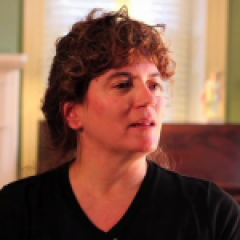Teaching Math: The Driftwood and the Vortex (Michele Kerr)
Michele Kerr is a second-career teacher, credentialed in math, history, and English, with a master’s in education from Stanford University, She teaches math from CAHSEE prep to pre-calc at Kennedy High School in Fremont, CA. She also wrote about teaching English in an previous guest post.
“Ms K, I need to do my work with Ms. V. My education plan is my civil right!” Deon’s entire body was contorted in a geometric impossibility, the better to shout at me from the back of the room.
“Hey, Ms. K! Come here! What if both numbers are negative?” Sticks was waving me over.
“If the rise and run are both negative, the slope’s positive. Just like multiplying!” Jack argued, as Cal watched dispassionately.
Welcome to the first month of my math support class, for juniors and seniors who haven’t yet passed California’s High School Exit Exam (CAHSEE). Snapshots from a typical day:
- Deon and Mack in exile, Deon facing east in back, desk jammed up against the full-wall closet, Mack facing due north, desk flush against the middle of the wall. The two would scream at me for a few minutes, demanding to be released to their guided studies teacher now that I had successfully removed anything remotely resembling fun from their grasp. Eventually, they growled various forbidden words and subsided into something approaching silence.
- Miguel and Eddie obliviously tagging my whiteboards with my precious student markers that I’d taken away twice already.
- Yesenia and Juan, a brother-sister pair who only spoke Spanish, chattering away about anything but math with Pauly Jay who, in a class that’s half Hispanic, is nonetheless my only bilingual student.
- JattJeet dozing off, Tavon fixing me with a hostile stare for disrespecting Deon and Mack.
- Johnny wandering aimlessly, resplendent in a teal plaid shirt and striped turquoise shorts, wearing a pink winter girl’s hat and a purple school blanket wrapped round his shoulders over his backpack, which he never took off.
- Atamai whirling around on a wheeled free-standing chair, stopping only to shout a math question at me or argue when I told him to put his posterior back in a desk.
- Brian tuning out the world with music, having surreptitiously put his earpieces back in when I wasn’t watching.
- Jack, Cal, Victor, and Sticks usually working on the assignment for the day.
And so it went.
Juniors and seniors who haven’t yet passed the seventh-grade standard-based CAHSEE are kids for whom math presents a serious challenge. A class of students with mostly low motivation and widely varying but generally weak math abilities is first and foremost a management problem, and a huge part of the management problem is the math. In order to maximize learning time, a teacher has to manage not only the students, but the math.
First task in managing the students: separate the vortex from the driftwood. The disruptive vortex sucks all the driftwood into his wake, where all spin about endlessly and, alas, happily, in circles all the way to the bottom. Pull out the driftwood and nothing changes. Move the vortex and the driftwood go back to floating about aimlessly, amenable to redirection. The quintessential disruptive vortex, Deon could single-handledly destroy half the class’s productivity if left undisturbed; his absence or isolation always left most of my “driftwood” students open to the idea of getting some work done.
The much rarer productive vortex students capture driftwood and spin it in the right direction. I was blessed with two. Seated with Jack and Cal, Sticks and Victor would compete madly to get the most work done; left to themselves, Sticks would toss wads of paper at JattJeet, with Victor shouting direction vectors. Understand that “good” kids and “bad” aren’t useful distinctions: Jack and Cal had the occasional zero-productivity hour, and all kids had days in which they settled down and learned. Deon was a math-solving machine who worked fiendishly once I isolated him from all other entertainment.
After carefully managing vortices, I sat the rest of the students so that no one, ideally, was next to a buddy. I ruthlessly rearranged students for the sole purpose of ruining their social hour, and pushed hard upon pain points (no music during practice, an F for the day) for any misbehavior. Then I had to figure out who to call and what to write when students left to go to the bathroom and never came back.
By the end of that first month, I occasionally ended class declaring that everyone had a daily F, and often endured various bleats of “Ms. K, why you so mean? Why you yelling? Chill out,” from kids whose voice volume went up to 11. But most days we had fun. And no matter how crazy the class got, I taught math every single day.
Onto managing the math, so that the driftwood would move in the right direction, and preparing the students for the test.
The students have multiple opportunities to take the test. I aimed my preparation push for the November test, with the February test as a backup. Of the original eighteen students, I thought nine would pass by November, or get close to it. Their existing math knowledge wasn’t so much the problem as was their inexperience in high-stakes tests. The other half did not appear to have the language, motivation, and/or math skills to pass, but at least I could teach them some math they could use when they finally got around to wanting it badly enough.
But even that limited goal was a challenge. I learned how long I could run an upfront discussion before their attention waned, carefully timing the moment when I moved them onto practice problems—which had to be carefully managed, too. Struggling students need to build momentum on a string of problems before they get to their first hesitation point. Hit that hesitation point too early and they “shut down”. They look away and find a more rewarding activity: talk to their neighbor, take a nap, turn up the volume on their iPod, sketch, tiptoe out of the room when I’m not looking, send objects airborne in pursuit of a target. Finding worksheets that started with problems simple enough to get them working and then built to more challenging work that wasn’t too hard took up a big chunk of my day. I’d spend hours looking through practice sets to be sure they didn’t leap to tough problems too soon, and often just wrote a dozen or more identical problems on the board, simply varying the numbers. Even with all that effort, some concepts were still too hard for some students, and I couldn’t always reach each one before he got pulled into a disruptive vortex. And so, from managing the math back to managing the students.
I lived for the days when I scored a win. Much is made by both reformers and progressives about the soul-killing nature of drill, but I got hooked on the genuine triumph my students felt when they worked a whole set of problems correctly. They beamed and bragged. Stickers were not unappreciated, or maybe a big red star with a smiley face. They didn’t mind the drill. They minded that they couldn’t do the drill, and so pretended they didn’t want to.
Sometimes students could do the work but just decided not to that day. Long ago, all these students learned that the relationship between effort and result was non-linear with no guarantee of a payoff. That this payoff was passing the CAHSEE, something they needed in order to graduate, was sometimes forgotten in the moment. But it’s not as if I could offer a guarantee. Some students never do pass the CAHSEE.
“Improving teacher quality” is the buzzphrase for 2013. Yet none of the challenges I’ve recounted are addressed by higher teacher Graduate Record Exam (GRE) scores, and an understanding of multivariable calculus offers no tools for managing a student howling nonsensical accusations about his rights under the Individuals with Disabilities Education Act. No conclusive research on superior discipline approaches can inform ed schools of the best way to prepare teachers to help students with complicated motivations and no real desire for academic excellence. Meanwhile, education reformers point accusingly to the very existence of high school students who haven’t yet mastered fractions and percentages as de facto evidence of incompetent teachers with inadequate knowledge, even though all of my students had been taught these concepts dozens of times over the years, from both traditional and “reform” approaches.
Another catchphrase these days is “grit”. While academically they might be driftwood, my students are a forceful, opinionated group who questioned my own views on politics and social policies (“Ms. K, what’s your position on alcohol?” “Upright. Bad idea to drink lying down–and never consume before 21, of course.”). Many hold jobs. At least one is a committed and dedicated athlete. While some have abysmal Grade Point Averages (GPAs), others are respectably above 2.5. Several seniors have done well enough on the Armed Services Vocational Aptitude Battery (ASVAB) to qualify for military service.
Five of the nine students on my “should pass” list did, in fact pass, Jack and Deon in October, the other three in November. Two of the remaining four got “high fail” scores; the other two did about five points lower than I would have liked. All four on the “should pass” who didn’t probably did well in their February test. Of the remaining nine with more challenging skill deficits, at least half will find the motivation, the focus, or the language skills in the next year to succeed. The others have the option to waive the requirement.
Reformers will judge me for the low pass rate. As a long-time test prep instructor, I judge myself for the four who didn’t pass in November, and will continue to look for better tools. But as a teacher, I judge myself by the degree to which my students develop increased confidence and competence in their math skills, as well as the degree to which they take more responsibility for their academic choices.
And on those criteria, I am content. All the students improved their understanding of proportional thinking, linear equations, and binomial multiplication, skills which will help them move through the high school math track. Sticks is now doing well in my geometry class. Victor stopped by two days before the February CAHSEE asking for practice material to brush up, and Brian visited to give a full report of his performance after the same. Jack and Cal are studying for their college placement tests.
On the last day of class, I read this article’s opening paragraphs to my students. They listened in total silence and then burst into applause, with faces that I must describe as shining. Some of them picked their own pseudonyms. While none said so directly, they are clearly pleased and proud I’d chosen to write their story. As I looked out at the class I’d worked so hard to teach, I remembered my students make their own judgments. Clearly, I hadn’t done too badly in their estimation—and I wouldn’t be a teacher if that assessment didn’t matter most.
This blog post has been shared by permission from the author.
Readers wishing to comment on the content are encouraged to do so via the link to the original post.
Find the original post here:
The views expressed by the blogger are not necessarily those of NEPC.


